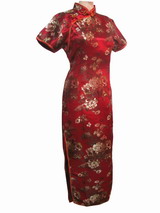Asian Fashion >>
Chinese Qi Pao Clothing
From Wikipedia
 The
qi pao or chi pao also known as the cheongsam or mandarin gown, is a
body-hugging (after Shanghai modification) one-piece dress for women. The
English loanword cheongsam comes from the Cantonese pronunciation of the
original Shanghainese term. In most western countries and in the Cantonese
dialect cheongsam is the name of a garment worn by both men and women. Chinese
who do not speak the Cantonese dialect view the cheongsam as an exclusively male
dress and use the word qi pao for its female equivalent. In Cantonese usage the
word qi pao is either interchangeable with the female cheongsam or refer to the
two-piece qi pao variant that is popular in mainland China
The
qi pao or chi pao also known as the cheongsam or mandarin gown, is a
body-hugging (after Shanghai modification) one-piece dress for women. The
English loanword cheongsam comes from the Cantonese pronunciation of the
original Shanghainese term. In most western countries and in the Cantonese
dialect cheongsam is the name of a garment worn by both men and women. Chinese
who do not speak the Cantonese dialect view the cheongsam as an exclusively male
dress and use the word qi pao for its female equivalent. In Cantonese usage the
word qi pao is either interchangeable with the female cheongsam or refer to the
two-piece qi pao variant that is popular in mainland China
When the
Manchu established the Qing Dynasty
over all of China, certain social strata emerged. Among them were
the Banners, mostly Manchu, who as a group were called Banner
People. Manchu women typically wore a one-piece dress that came to
be known as the qia pao. The qi pao fit loosely and hung straight
down the body. After 1644, all Han Chinese were forced to make a
close shave and dress in cheongsam instead of Han Chinese clothing,
or they were to be killed. For the next 300 years, the cheongsam
became the adopted clothing of the Chinese. The garment proved
popular and survived the political turmoil of the 1911 Xinhai
Revolution that toppled the Qing Dynasty
. The qi pao has become, with few changes, the archetypal dress for
Chinese women.
The modern version of the qi pao was first developed in Shanghai
around 1900. Slender and form fitting with a high cut, it contrasted
sharply with the traditional qi pao which was designed to conceal
the figure and be worn regardless of age. In Shanghai it was first
known as (or long dress. Mandarin: chángshān, Cantonese: cheongsam,
Shanghainese: zansae).
 The
modernized version is especially noted for accentuating the figures
of women, and as such is highly popular as a dress for high society.
As Western fashions changed, the basic cheongsam design changed too,
introducing high-necked sleeveless dresses, bell-like sleeves, and
the black lace frothing at the hem of a ball gown. By the 1940s,
cheongsam came in transparent black, beaded bodices, matching capes,
and even velvet. Later, checked fabrics also became quite common.
The
modernized version is especially noted for accentuating the figures
of women, and as such is highly popular as a dress for high society.
As Western fashions changed, the basic cheongsam design changed too,
introducing high-necked sleeveless dresses, bell-like sleeves, and
the black lace frothing at the hem of a ball gown. By the 1940s,
cheongsam came in transparent black, beaded bodices, matching capes,
and even velvet. Later, checked fabrics also became quite common.
The 1949 Communist Revolution ended the cheongsam and other fashions
in Shanghai, but the Shanghainese emigrants and refugees brought the
fashion to Hong Kong where it has remained popular. Recently there
has been a revival of the Shanghainese cheongsam in Shanghai and
elsewhere in Mainland China; the Shanghainese style functions now
mostly as a stylish party dress (see also Mao suit).
Many secondary schools in Hong Kong use a plain rimmed sky blue
cotton and/or dark blue velvet (for winter) cheongsam with the
school badge as part of a basic uniform for their female students to
be worn to regular classes. Schools known to set this standard
include St. Paul's Co-educational College, St. Stephen Girl's
College, etc.
In the 1950s, women in the workforce started to wear more functional
cheongsams made of wool, twill, and other materials. Most were
tailor fitted and often came with a matching jacket. The dresses
were a fusion of Chinese tradition with modern styles.
The Tibetans and Vietnamese (ao dai) have related versions of this
dress as their national dress.
Advertisement